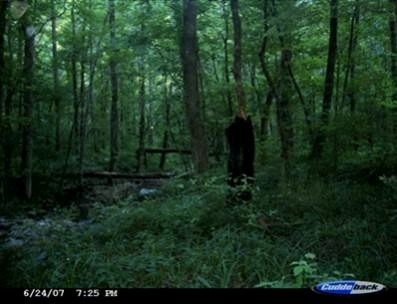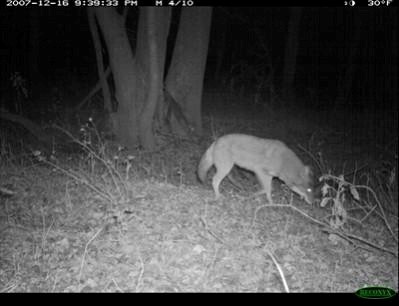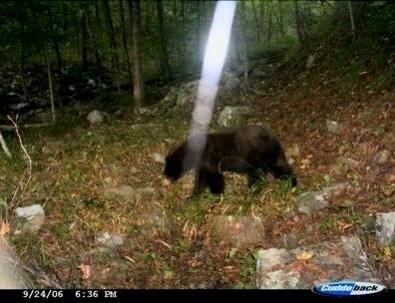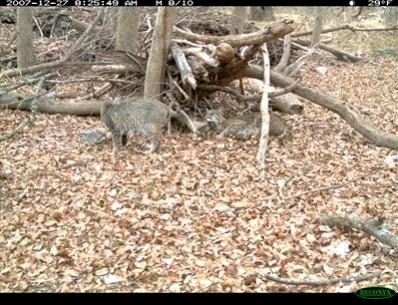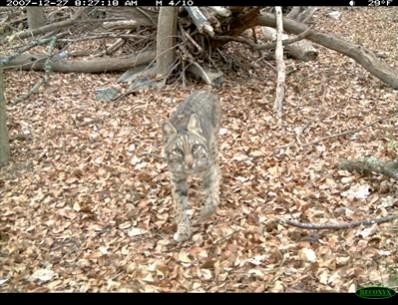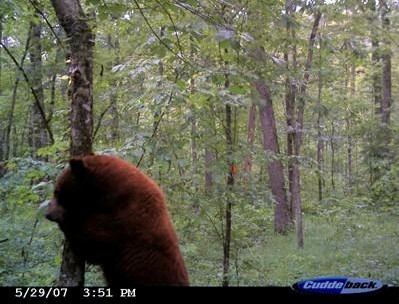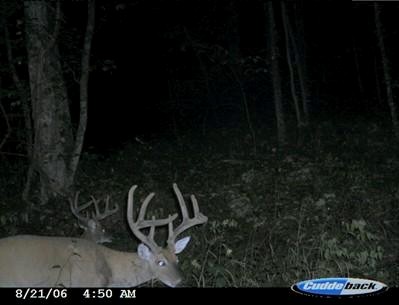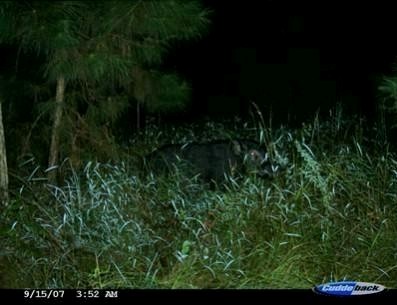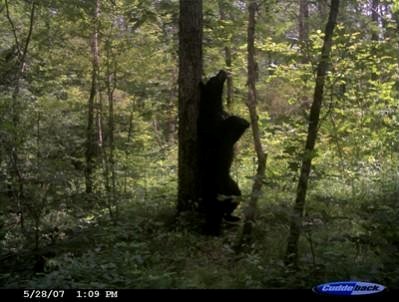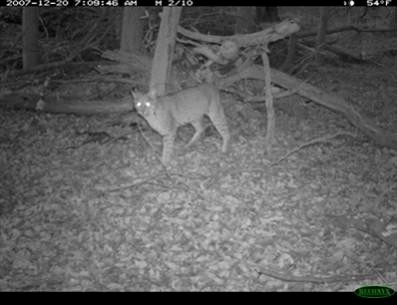Last updated on February 10th, 2025 at 01:37 pm
Report for camera trap project undertaken from 2006 – 2011 by the North American Wood Ape Conservancy. The project was concluded in early 2011 with no photo-captures of wood apes.
Updated with embedded video clips.
Report compiled by Daryl G. Colyer and Alton Higgins
Principal photography by Chris Buntenbah
With assistance from Jeremy Wells, Ken Helmer, Mike Mayes and Paul Bowman
Abstract
The North American Wood Ape Conservancy is actively proceeding with plans to obtain compelling photographic and/or video evidence through a long-term remote camera trap project based on the premise that such evidence can suffice to secure recognition of the existence of a large undocumented primate species. From that point, more intense and properly funded research would enable the collection of further and additional forms of evidence, including, ultimately, sufficient physical evidence to permit either the formal designation of a previously uncatalogued species or the recognition of the wood ape as the descendent of a previously described species such as Gigantopithecus blacki.
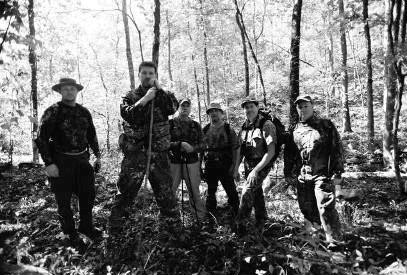
Introduction
Sightings of huge hairy bipedal apelike creatures have been documented for hundreds of years in North America, and specifically in areas of Arkansas, Louisiana, Texas and Oklahoma. Individuals reporting the sightings come from all classes, colors, and cultures. The non-profit North American Wood Ape Conservancy, or NAWAC , maintains that the source of the phenomenon is a biological entity. As such, in spite of its probable rarity, over time it should be possible to photograph the wood ape species, colloquially and widely known as the sasquatch or bigfoot.
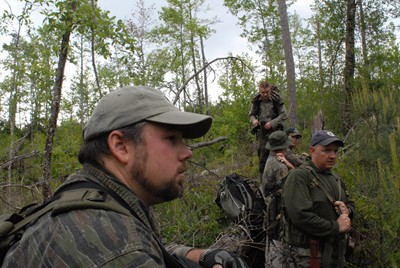
In lieu of a specimen, securing compelling images is considered a necessary precursor in the species documentation and validation process. One of the world’s leading field biologists, Dr. George Schaller, in comments regarding the wood ape phenomenon, recently stated, “A hard-eyed look is absolutely essential. The best thing to do would be to set up camera traps that automatically take pictures of the animals. If this is monitored for a year, you may get nothing, but you may end up with some interesting wildlife pictures…”
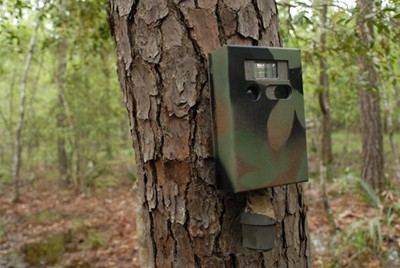
Other prominent scientists agree with Dr. Schaller’s call for photographic evidence. For example, Dr. Duane Schlitter, who oversees the Texas Parks and Wildlife Department’s (TPWD) Non-game and Rare and Endangered Species program, had this to say: “To conclusively prove…bigfoot in Texas, we [TPWD] would need an image [photographic or videographic] that included details to show us that it was not a doctored or edited image in any way…”
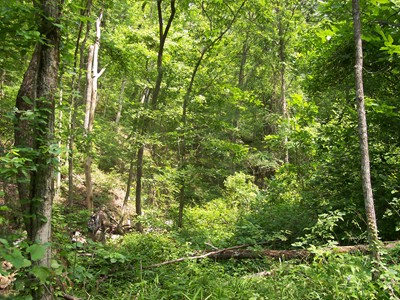
Such comments serve to bolster NAWAC efforts regarding wood ape documentation. However, the probable rarity of the species, combined with its elusive nature, possible nocturnal habits, unpredictable behavior, and vast home environment, makes simply locating an individual, not to mention photographing one, an exceedingly difficult proposition.
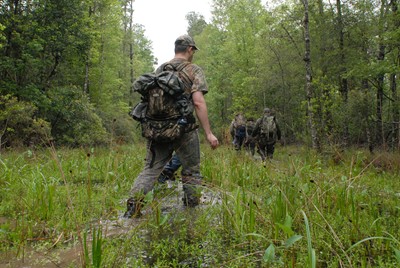
Volunteers can only contribute a limited amount of time toward sporadic verification endeavors. By its nature, field biology is not easy. Dr. Ken Goldberg of the University of California, Berkeley, who has created a “robot” photographer for use during rare species documentation efforts, agrees: “Field biology is very difficult. You have to go out somewhere remote; it’s lonely, it’s cold [or hot], it can be downright dangerous; and the presence of a human observer can affect the behavior of the animals you are trying to study.”
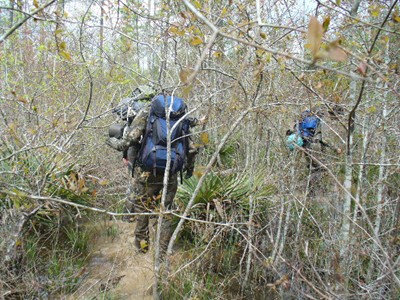
Because of the nature of the challenge, sustained field study is needed. Since it is not currently possible to finance full-time investigators, another approach is required to augment NAWAC activities. The NAWAC Board of Directors, inspired and encouraged by scientists such as Dr. Schaller and Dr. Schlitter, decided to employ the same kinds of strategies and equipment as used by mainstream research teams to confirm the presence of rare or elusive species of wildlife in remote locations, animals such as the Ivory-billed Woodpecker (Campephilus principalis), by Cornell University and University of Auburn research teams, the snow leopard (Panthera uncia) by the Snow Leopard Conservancy, and the unlisted Orang Pendek, a reportedly small bipedal hominoid, by National Geographic research teams.
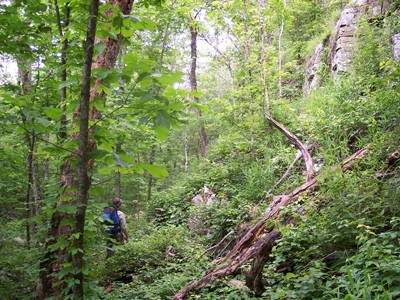
Hypothesis
As mentioned above, the NAWAC hypothesizes that an unlisted rare primate species, the wood ape, exists in remote places on the North American continent , and that it is the source for thousands of sightings reported for centuries of a large bipedal animal widely known as the sasquatch or bigfoot. Furthermore, the NAWAC hypothesizes that a small population of the species resides in Texas, Oklahoma, Arkansas and Louisiana in areas characterized by abundant rainfall, waterways and bodies of water, dense forest (upland pine and hardwood bottoms) and low human population densities.
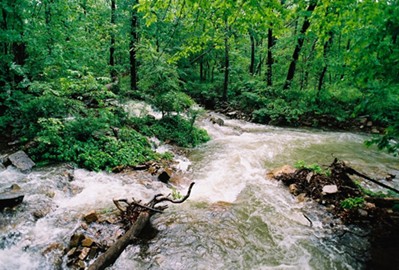
Natural history has provided at least one possible candidate that closely meets the physical characteristics of the wood ape. Gigantopithecus blacki, presumed to have gone extinct, was a huge ape, known from the fossil record to have existed as recently as 250,000 years ago in Asia. While its bipedalism is debated, its size is not; adult G. blacki reached heights of more than nine feet when standing erect. It was originally suggested that G. blacki was an herbivore, like its present day cousins, the orangutan (Pongo pygmaeus) and gorilla (Gorilla gorilla), but recent studies suggest that it may have been much more of an opportunistic omnivore, more aptly fitting reported observations of the wood ape.
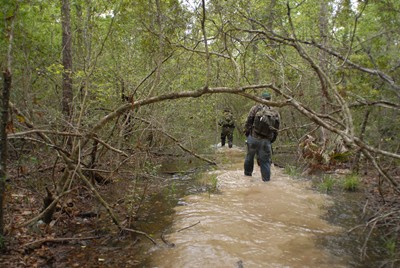
Although G. blacki fossils have not been found in North America, it is reasonable to suggest that the species may have crossed the land bridge that once connected Asia to North America, as was the case with many species of plants and animals living today. Fossil remains of Asian species, such as the red panda (Pristinailurus bristoli), an ecological contemporary of G. blacki, have been discovered in North America (Washington and Tennessee). Such findings provide supportive evidence that the “great ape hypothesis” is at least plausible.
Objective
The NAWAC seeks to provide videographic and/or photographic evidence, through the use of numerous digital high-speed camera traps, that the wood ape does indeed exist, leading to official scientific recognition and governmental protection of the species.
If definitive photographic and/or video evidence is obtained, the NAWAC hopes to work to secure habitat and secure definitive physical evidence. The mission of the organization is not only to investigate and conduct research regarding the species’ existence, but also to facilitate official scientific and governmental recognition, in addition to conservation and protection of the species and its habitat once discovery and documentation have taken place. Operation Forest Vigil is designed expressly for purposes of fulfilling this mission. The NAWAC will confer with officials for steps leading to official listing of species (papers for publishing in scientific journals, etc.). In all likelihood, such a momentous event will lead to an immediate declaration that the species is rare and endangered. It is also hoped that significant levels of private and governmental funding will be directed toward promoting conservation of critical habitat areas, enabling the NAWAC to conduct and/or facilitate prolonged field studies of the species.
Background/Methods
Sighting reports and NAWAC field investigator observations (e.g., track finds, visual contacts, and aural detection) over the course of the last few years led to the selection of several general locations for focused field investigations. Some of these activities are summarized on the NAWAC website. Based on a variety of assessments, a few specific places were selected for Operation Forest Vigil (OFV).
Since April 2006, NAWAC teams have repeatedly ventured into remote areas to deploy and maintain camera traps for prolonged monitoring projects. A camera trap, simply put, is a camera placed in a remote outdoor setting that is activated by detecting motion and body heat of wildlife. The use of some sort of lure or bait may or may not be used. The camera traps are normally mounted on trees or logs and provide a constant quiet eye in remote and rarely-accessed (by humans) wilderness areas, taking photos and one-minute videos. The power supply for the camera traps usually must be replenished every 60 – 90 days. The NAWAC uses all digital camera traps with 1 – 2 gigabyte memory cards, so that it is possible to collect thousands of images and video without having to constantly return to the camera traps. This method allows the areas to remain largely undisturbed for months from human intrusion.
NAWAC investigators are committed to the project, knowing that there have been a number of recorded images of rare or previously unlisted animals by camera trap projects. Among these animals are the Sumatran rhino (Dicerorhinus sumatrensis), the Chinese mountain cat (Felis bieti), the giant muntjac in Vietnam (Muntiacus vuquangensis), the rare Sumatran striped rabbit (Nesolagus netscheri), and Jackson’s mongoose (Bdeogale jacksoni) in Tanzania. In August 2007, a camera trap in Minnesota captured an image of a cougar (Puma concolor), pushing officials to reevaluate their dismissive stance regarding reported cougar sightings there. In Arizona, camera traps have recorded images of at least two different jaguar individuals (Panthera onca), indicating the presence of jaguars in what was once part of their northern range.
The OFV locales are in East Texas and the Ouachita Mountains of Arkansas and Oklahoma; in the future, the NAWAC may also focus attention on other areas within the four-state region. Where necessary, the NAWAC is operating within the parameters of federal governmental entities. These areas are among the most rugged, remote and densely forested areas in the four-state region. Indeed, providing maintenance to the camera traps has come at a high price, and not just in terms of finances and resources. During OFV, NAWAC volunteers endured a variety of injuries and maladies, such as fractured bones, deep contusions, parasites (Giardia lamblia) and Lyme disease, or borreliosis, to name just a few.
The NAWAC will continue to periodically revisit the areas (typically every two to three months, depending on equipment capabilities and host requirements) to retrieve images and replenish power supplies. The current plan is to continue the project for a minimum of ten years.
Additional camera traps will be added to current arrays as NAWAC personnel and interested donors contribute funds or equipment for the operation, and/or as grants are acquired. As of May 2007, the NAWAC had approximately 20 digital camera traps deployed; by December 2007, roughly 30 digital camera traps were deployed. The long term goal is to have 100 camera traps in the field and fully operational by 2012 (this goal was not met; the NAWAC deployed roughly 40 camera traps during Operation Forest Vigil).
Equipment
Many of the cameras and related equipment were purchased using funds acquired through NAWAC -sponsored educational and fundraising events supporting the organization’s mission statement (Texas Bigfoot Conference). Cash and equipment donations from anonymous donors and NAWAC members provided the balance of the gear employed in the operation to this point in time. As mentioned above, the long term goal is to deploy, operate and maintain no fewer than 100 high-quality, high-speed, digital camera traps. Such a plan will require significant funding.
Imaging equipment used so far include the Reconyx RC55 Rapidfire™ Color IR digital camera and Cuddeback™ C3000, 3.0 and 2.0 digital cameras. The Reconyx cameras are capable of “rapid-fire” repetitive bursts of photos, in near-video mode; the NAWAC began using Reconyx camera traps during the last quarter of 2007. In March 2008, the NAWAC was set to deploy another group of camera traps consisting of the newly-developed Reconyx RC60 Rapidfire™ Covert IR digital camera.
Many of the Cuddeback cameras in use are also capable of recording one-minute segments of daytime video in addition to capturing still photos. Both Reconyx and Cuddeback brands are known for their trigger speeds. The Reconyx RC55 cameras have an extremely quick trigger speed of .25 seconds; the Cuddebacks have a trigger speed of about .80 seconds.
In Arkansas and Oklahoma, specifically, the heavy-duty Swivel Safe™ Security Boxes and the Non-Typical Cuddeback™ Bear Safe Boxes turned out to be extremely useful as black bears attempted to wreak havoc with camera traps while they were being filmed and photographed. The Swivel Safe™ Security Boxes are heavy and difficult to deploy, but they do make it extremely difficult to tamper with the camera traps or steal them, short of cutting down trees on which the camera traps are fastened.
Petition for Support
A frustrated observation repeatedly expressed by team members while executing Operation Forest Vigil camera trap deployments and maintenance visits concerned the marked discrepancy between the vastness of the habitat and the miniscule number of cameras. Even though thousands of dollars have been spent on camera equipment (not to mention ancillary paraphernalia, travel costs and other related expenses), the current level of coverage represents literally less than a drop in a bucket in the targeted locales. One hundred digital camera traps would not be too many. Generally, the cost of purchasing, equipping and deploying one camera trap is roughly $700 – $800. This cost does not include maintenance of the camera trap. Many camera traps need to be deployed in prime areas and left to operate around the clock for long periods of time.
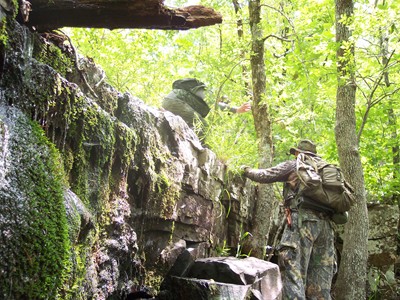
Please contact the NAWAC if you are interested in providing camera traps or funding the research objectives of Operation Forest Vigil. All donations, contributions, gifts and transfers to the tax-exempt North American Wood Ape Conservancy are fully tax-deductible.
Acknowledgements
We thank the land owners, hosts and custodians (both private and governmental) for their cooperation and accommodation in permitting us to execute Operation Forest Vigil on their property. We also extend our sincere appreciation to all the eye witnesses who have come forward and shared their experiences; without them we would hardly know where to begin. Last but not least, we thank all those who have donated equipment and funds to the NAWAC.
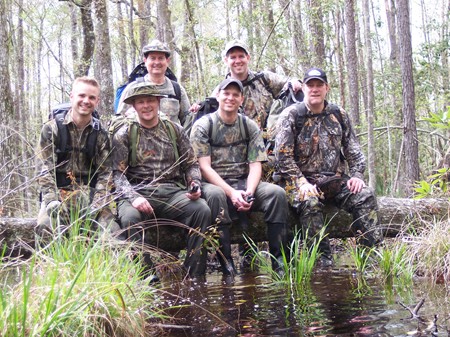
Equipment and products used by the NAWAC during OFV includes:
- Camelbak Hydration Packs
- Cuddeback™Digital Wildife Scouting Cameras (C3000, 3.0 & 2.0)
- Custom-printed seamless waterproof USGS topographic maps
- Garmin GPS units
- ITT 160 & ITT 190 3rd generation handheld night vision monoculars
- Marantz PMD 670 Compact Flash Recorders
- Meals-Ready-to-Eat
- Reconyx RC55 Rapidfire™ Color IR and RC60 Rapidfire™ Covert IR digital cameras
- RedHead® Bone-Dry® Hobbs Creek™ Hip Waders
- Rocky Boots
- Satellite Imaging
- Sennheiser microphones
- Sony MZR37 MiniDisc recorders
- Sony video cameras
- Swivel Safe – Protect Your Image (Camera Security Boxes)
- TOPO! State Series GPS compatible mapping software
- Waterproof cases, including Pelican Micro 1060 waterproof case w/hanging cord & fleece neck warmer
References
Bindernagel, J. A. (1998). North America’s Great Ape: The Sasquatch. 270 pp. Beachcomber Books. Courtenay, B.C., Canada.
Casstevens, David. (October 31, 2005). Sasquatch Watch, Interview with Dr. Duane Schlitter. Ft. Worth Star Telegram. Ft. Worth, Texas.
Ciochon, Russell L. (2002). The Ape That Was. University of Iowa. Online article.
Colyer, D. & Higgins, A. (2005, revised in 2012). Wood Ape Sightings: Correlations to Annual Rainfall Totals, Waterways, Human Population Densities and Black Bear Habitat Zones. Online article.
Fildes, Jonathan. (Sunday February 18, 2007). Robot watches out for woodpecker, Interview with Dr. Ken Goldberg. BBC News. San Francisco, California.
Gray Fossil Site, East Tennessee State University. (2004). Second record of the Red Panda in North America. Online article.
Hill, Geoffrey E. (2007). Why we should continue looking for the bird [Ivory-billed Woodpecker]. Birder’s World Magazine Online. Kalmbach Publishing Co. Brookfield, Wisconsin.
In Search of Orang Pendek. Camera-Trapping. Online article.
Kahn, Jeremy. (November 2007). On the Prowl. Smithsonian Magazine. Online article. Washington, D.C.
Mendenhall, Matt. (2007). Ideal remote camera for locating Ivory-bills is just an idea. Birder’s World Magazine Online. Kalmbach Publishing Co. Brookfield, Wisconsin.
Meldrum, Jeff. (2006). Sasquatch: Legends Meets Science. 304 pp. Forge Books. New York, NY.
Stein, Theo. (Sunday, January 05, 2003). Bigfoot Believers, Interview with Dr. George Schaller. Denver Post. Denver, Colorado.
Personal communication with Dr. Duane Schlitter, August 2007.
Pradeep, K. (Sunday, October 1, 2006). Man of Nature, Interview with Dr. George Schaller. The Hindu, Online edition of India’s National Newspaper. India.
Rizzo, Will. (December 2005). Return of the Jaguar? Smithsonian Magazine. Online article. Washington, D.C.
Rohrbaugh, Ron and Rosenberg, Ken. (October 2006). Final Report, Summary and Conclusions of the 2005–06 Ivory-billed Woodpecker Search in Arkansas. Submitted to U.S. Fish and Wildlife Service. Cornell Lab of Ornithology, Cornell University. Ithaca, New York.
Sightings Database. Texas Bigfoot Research Conservancy.
The Snow Leopard Conservancy. Determining Snow Leopard Populations using Camera Traps. Online article.
